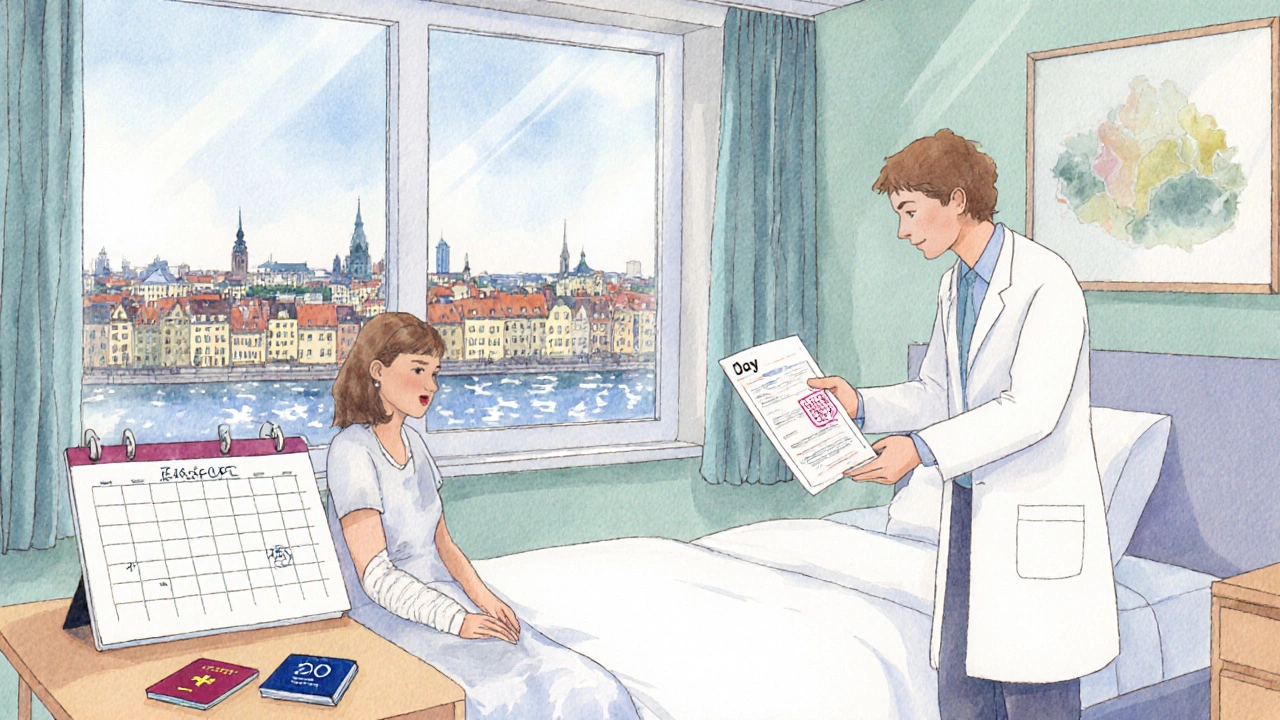Sick Leave Country Comparison Tool
Sick Leave Comparison Tool
Compare paid sick leave policies across countries. Select a country to see detailed information about maximum days, pay rates, and eligibility requirements.
Select a country to view details about paid sick leave policies
When it comes to falling ill while traveling, the amount of paid sick leave you can take without losing income can change the whole experience. Some nations hand out a generous quota of paid days, while others barely budge. If you’re planning a medical‑tourism trip or considering a move abroad, you need to know where the sick‑day pool is deepest.
Key Takeaways
- Sweden, Finland and Germany top the list with up to 30‑35 paid sick days per year.
- Eligibility often hinges on employment contracts, residency status, and contributions to national insurance.
- Medical tourists can sometimes tap into local sick‑pay schemes, but rules vary sharply.
- Plan ahead: bring proof of health insurance, understand the employer’s policy, and know the local reporting process.
What Exactly Is Paid Sick Leave?
Paid sick leave is a statutory or contractual benefit that lets employees stay home for health reasons while still receiving a portion of their salary. The concept originated in Europe during the early 20th century and has since spread, but the exact number of days and the pay rate differ from country to country.
How Countries Measure Sick‑Leave Entitlements
Most governments publish an annual maximum - the highest number of days an employee can be absent and still get paid. Some nations use a calendar‑year cap, others count based on a rolling 12‑month period. Pay rates also vary: a few countries pay 100 % of the regular wage, while others drop to 70‑80 % after a certain threshold.

Top Countries with the Highest Paid Sick Days (2025)
| Country | Maximum Days per Year | Pay Rate | Eligibility Threshold |
|---|---|---|---|
| Sweden | 35 | 80‑100 % | 6 months of employment |
| Finland | 35 | 80‑100 % | 6 months of employment |
| Germany | 30‑35 (depends on employer) | 70‑100 % | 4 weeks of contribution to health insurance |
| Denmark | 30 | 95 % | 9 months of employment |
| Norway | 30 | 100 % | 3 months of contribution to National Insurance |
| United Kingdom | 28 (Statutory Sick Pay) | £99.35 per week (2025 rate) | 4 days of work under same employer |
| Australia | 10 (National Employment Standards) | 80 % | 6 months of continuous service |
| Canada | 15 (varies by province) | 70‑100 % | 3 months of insurable hours |
| France | 30 (after 1 year of service) | 90‑100 % | 1 year of contribution |
| Netherlands | 30 (commercial contracts) | 80‑100 % | 12 months of employment |
Eligibility - Who Can Actually Use Those Days?
Even in the most generous systems, you can’t just walk in and claim a month of sick pay. Here’s a quick snapshot of the usual gates:
- Employment contract - Most European countries require a written agreement that spells out the sick‑leave entitlement.
- Residency or work‑permit status - Non‑EU visitors often need a local work permit or long‑term residency to access national sick‑pay schemes.
- Social‑security contributions - Countries like Germany and Norway tie eligibility to a minimum period of contributions to health or unemployment insurance.
- Medical certification - A doctor’s note is typically mandatory after the first two days of illness.
If you’re a medical tourist, you’ll often fall into the “short‑term visitor” bucket, which means you might not qualify for the full national program. However, many private hospitals bundle short‑term sick‑pay coverage into their treatment packages.
What This Means for Medical Tourists
Imagine you’re flying to Sweden for a joint‑replacement surgery. The hospital offers a 30‑day post‑op stay, but you catch a flu on day 10. Because you’re a tourist, you won’t automatically receive Sweden’s statutory sick pay. Instead, you have three options:
- Rely on your home‑country health insurance to reimburse the lost income.
- Purchase a short‑term disability add‑on from the hospital’s insurance partner.
- Take unpaid leave from your job back home, if your employer allows it.
Countries with a strong private‑insurance market, like Australia and Canada, often have packages that cover both medical costs and a portion of lost wages for short stays.
Pitfalls to Watch Out For
- Cap limits are often annual - If you’ve already used 20 days in the current year, you only have the remainder left.
- Pay rate drops after a threshold - In Germany, the first six weeks are paid at 100 % of your salary, then it falls to 70 %.
- Documentation delays - Some health ministries take weeks to process sick‑pay claims, which can be stressful if you’re abroad.
- Employer policies differ - Even within the same country, a multinational can offer a more generous internal sick‑leave scheme than the statutory minimum.
Checklist for Planning a Sick‑Leave‑Friendly Medical Trip
- Verify your home‑country insurance covers loss of earnings abroad.
- Ask the destination hospital about short‑term disability coverage.
- Check the host country’s residency and contribution requirements.
- Bring a digital copy of your medical history and a doctor’s note in the local language.
- Confirm the employer’s remote‑work or unpaid‑leave policy before you leave.
- Set up a local bank account if you expect to receive any statutory payments.
Quick Recap
If you’re looking for the biggest sick‑leave pool, the Scandinavian trio-Sweden, Finland, and Germany-lead the pack, offering up to 35 days a year at near‑full pay. Yet, as a medical tourist, the real bottleneck is eligibility. Make sure you negotiate a private‑insurance add‑on or have a robust plan at home to cover any gap.
Which country gives the most paid sick days?
Sweden and Finland top the list, each offering up to 35 calendar days of paid sick leave per year, with pay rates ranging from 80 % to 100 % of the regular wage.
Can a medical tourist claim a country's statutory sick pay?
Usually not. Statutory sick pay is tied to local employment or social‑security contributions. Tourists can only access it through private insurance plans offered by the hospital or by using coverage from their home country.
Do all European countries pay 100 % of salary during sick leave?
No. Pay rates differ: Germany starts at 100 % for the first six weeks then drops to 70 %; Denmark pays about 95 %; the UK’s Statutory Sick Pay is a flat rate, not a percentage of salary.
What documentation is needed to claim sick leave abroad?
A medical certificate from a local doctor is usually required after the first two days. Some countries also ask for proof of employment, residence permit, and evidence of social‑security contributions.
Is there a global ranking of sick‑leave benefits?
The OECD and International Labour Organization publish comparative data, but the most up‑to‑date country‑by‑country tables are usually found in national labor ministry reports or specialist HR surveys.
